
Giant Telescopes of Tomorrow
In the 20th century, telescopes advanced greatly in size, with apertures of optical scopes expanding from just five feet to over 30, and radio dishes growing from 30 feet across to 1,000. Discoveries kept pace: We have mapped the Milky Way with its 100 billion stars, for instance, and now accept that the universe has billions of galaxies, many anchored by a supermassive black hole at the center. But to address some of the most pressing cosmological questions today—what is dark matter? dark energy? is there life elsewhere?—space scientists agree that we need much bigger and much better eyes on the sky. Below, see some of the giant optical and radio telescopes now under development.—Peter Tyson
Editor's note: This feature only touches on each of these telescopes; for more information, see the individual project websites. Note also that due to funding snags and other issues, some of these instruments may fall by the wayside or be replaced by others, including some that may already be in the planning stages but are not included here.


|
|
James Webb Space Telescope
Scheduled for launch in 2014, Webb will be seven times as sensitive as its predecessor Hubble. Able to pick out details the size of a Lincoln penny at roughly 25 miles, it will also represent an enormous gain in infrared sensitivity. This will allow it to peer deep inside dust clouds to study star and planet formation. To achieve this, Webb will be parked almost a million miles away from Earth, where a sunshade will block heat from the sun, our planet, and even the moon from striking the telescope's 21-foot mirror, allowing Webb to operate at just 50 degrees above absolute zero.
|
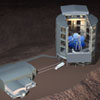

|
|
Giant Magellan Telescope
The GMT is one of several large ground-based optical telescopes in development. Situated high and dry in Chile, it will have seven primary mirror segments, each over 26 feet across, arranged like the petals of a flower. GMT team goals include investigating three of the hottest cosmic topics now on the table—dark matter, dark energy, and planets outside our solar system—as well as the formation of galaxies and the growth of black holes. Like its competitor giant scopes, it will feature adaptive optics, which corrects image distortions caused by our turbulent atmosphere.
|
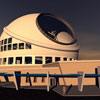

|
|
Thirty Meter Telescope
The TMT will be like a goliath version of Keck, currently the largest optical/infrared telescope with its twin 33-foot mirrors. Comprised of hundreds of segments, the TMT's composite mirror will be over 100 feet across, enabling it to see objects nine times fainter than Keck can. Altogether, the TMT will be able to gaze back to just a few hundred million years after the Big Bang, which astrophysicists put at 13 billion years ago. It, too, will enable the study of galaxy formation and of Saturn-sized exoplanets orbiting nearby stars, among other pursuits.
|
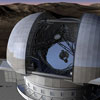

|
|
European Extremely Large Telescope
The E-ELT will dwarf all other optical/near infrared telescopes. Its multi-faceted mirror, 138 feet across, will have almost a thousand hexagonal segments each almost five feet wide. Like Magellan and TMT, astronomers will use it to conduct a kind of stellar archeology, analyzing the earliest galaxies, as well as to scrutinize the spectra of extrasolar planets for atmospheric conditions conducive to life. One hope is to directly measure, for the first time, the acceleration of the universe's expansion. A site will be chosen by the end of 2010.
|


|
|
Large Synoptic Survey Telescope
The LSST differs from the other ground-based optical telescopes in that it will have a wide field of view and will be able to move quickly between different areas of sky. Using the world's largest digital camera (3,200 megapixels), the LSST will do brief exposures of 10 to 20 seconds each. This will be ideal for investigating events too short-lived to be readily studied today, such as the trajectories of asteroids that might pose a threat to Earth. And by imaging the entire night sky every few nights, the LSST will offer, after about a decade of operation, the first "movie" of the universe.
|
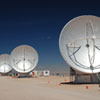

|
|
Atacama Large Millimeter/Submillimeter Array
Now being built in the Chilean desert, ALMA will be the world's most advanced radio astronomy observatory (and the highest, at 16,500 feet). Its main array will have 50 movable antennas, each almost 40 feet in diameter, that will act as a single immense telescope. ALMA will allow inspection of radiation from some of the coldest objects in the universe, such as the vast clouds in interstellar space where stars are born. Astrophysicists can use it to probe everything from gas being sucked into black holes to gas erupting from volcanoes on Jupiter's moon Io. Expected completion: 2013.
|


|
|
Low Frequency Array
LOFAR is also now under construction, centered in Holland (here, the first completed station), and it too will be large-scale. All told, 30,000 antennas spread across Europe will connect to a central supercomputer. LOFAR will focus on low radio frequencies. Like LSST, it will monitor a large part of the sky on an almost daily basis, enabling it to research transient radio sources. Radio astronomers will explore magnetic fields within nearby galaxies—an open problem—as well as the so-called "epoch of reionization," an enigmatic period when the universe was just a few hundred million years old.
|
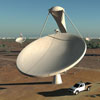

|
|
Square Kilometer Array
The SKA will have 30 times the sensitivity of today's best radio telescope. Covering radio frequencies different from those of LOFAR, it will have half a million square yards of collecting area. Half of this will be within an inner array with a three-mile diameter, to provide extremely high brightness sensitivity; the remainder will extend out over 1,800 miles. This will allow imaging of the faint emissions from the surface of stars, for example, and the interstellar medium of distant galaxies. The SKA will also be well-suited to seek radio signals from extraterrestrial civilizations.
|
|


We recommend you visit the interactive version. The text to the left is provided for printing purposes.
|









